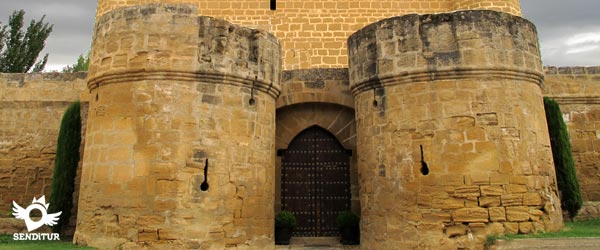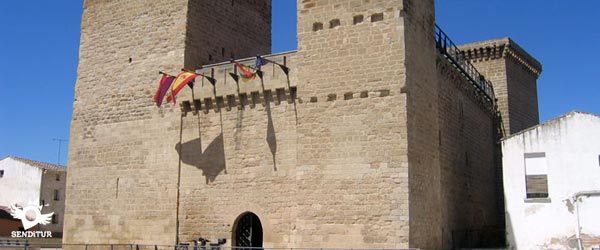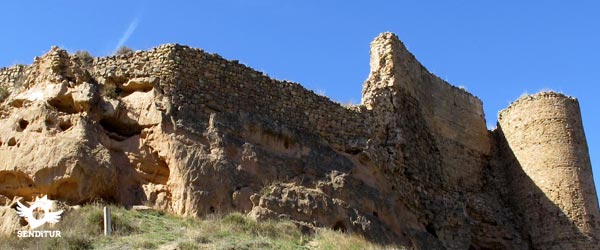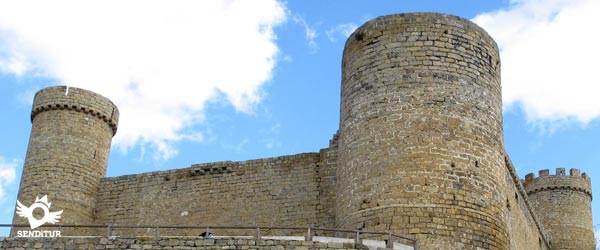Route of the Castles of La Rioja
Battles, conquests, silent history of a region
Battles, conquests, silent history of a region

Crossroads, fertile valley and natural border towards the Castilian plateau, La Rioja treasures a great history forged from time immemorial when it was the cause of disputes between the different tribes and cultures that lived here. After the reconquest, the Castilian kingdoms disputed its control, knowing the strategic and economic importance of controlling this region rich in resources. Mute witnesses of such a busy history are the different castles and defensive fortresses that in great number populate this region and that are located in valuable corners as if they were a game of chess.
The route of the Castles of La Rioja will take us to discover part of the Castles of La Rioja that still resist the attacks, and only of the time, in their strategic locations, from where we will be able to enjoy the magnificent panoramic that from them it has and that without a doubt were part of their strategic importance for the control of this region.

The town of Sajazarra, founder of the Alava Brotherhood together with Vitoria, Miranda de Ebro, Pancorbo and Salvatierra, marks the starting point of this route. This fortified town, famous for its Ancient Music Festival, houses the Castle of Sajazarra, one of the best preserved in the whole of La Rioja. Built in the fifteenth century and privately owned, the walk around its surroundings will take us back in time while we observe its homage tower culminated by battlements and matacanes or take us to discover part of the ancient wall that protected the town, border between the Obarenes Mounts and the wide valley of the river Tirón.


We left Sajazarra leaving behind us the sharp silhouette of the cliffs of Cellorigo, the site of another castle that no longer exists, where the Battles of Cellorigo took place, in which the troops of Alfonso III defeated on two occasions the troops of Al-Mundir, son of the emir of Cordoba Mohamed I, putting them in retreat. The road gives us the opportunity to approach Anguciana to visit the Torre-Fuerte de los Salcedo, another example of the military architecture so abundant in La Rioja. The N-232 will be our companion for a large part of the route, beginning our journey through it in the vicinity of Tirgo, where it could not be otherwise we will approach Cuzcurrita del Río Tirón to visit its well-preserved castle. This road leads us to our next stop, passing by the towns of Casalarreina, which is said to have been renamed Casalarreina by Juana I of Castile, and the town of Haro, capital of Rioja wine. Briones conserves its medieval structure and environment protected by its walls that delimit an urban centre set on the promontory in which the Briones Castle was erected back in the 13th century. An example of the nobility and importance that this town treasures are its well-kept palaces and emblazoned houses which, together with the rest of its historical and artistic heritage, make us put ourselves in the shoes of the watchman soldier, who from the top of the homage tower, the only remaining part of the castle situated here, observed the vast valley of the Ebro in search of enemy armies.


From the magnificent viewpoint of the tower we can see the next conquest to be carried out, we travel along the road that joins both towns and that leads us to cross the river Ebro to reach the interior of San Vicente de la Sonsierra, another clear example of a fortified town, known throughout the world not only for its wines but also for its traditions, such as that of the Picaos de San Vicente. In its highest part, looking for the strategic and defensive advantage that this situation provides, we find the walled enclosure that houses the remains of the Castle of San Vicente de la Sonsierra, dating from the twelfth century, and next to it, seeking protection, are the hermitage of the Vera Cruz of the thirteenth century and the church of Santa María la Mayor of the fifteenth century. Here we can visit the Clock Tower which houses the Clock Museum, or imagine for a moment that we left Picaos through the door of the hermitage of the Brotherhood of Santa Vera Cruz. The castle also preserves the tower of homage, and you can also see the different defensive lines that formed its walls.


As if it were the spearhead, our next stop has been in front of us on our last two visits, watching us at the top of the promontory on which it stands. We return to the march returning on our steps to meet again with the national one and to continue for her towards San Asensio, place of the popular Battle of the Clarete. Before arriving at this locality we will have to turn aside to direct us towards the following castle. The right moment of the detour is marked by the sign that indicates us the access to the station of the railroad of the locality, both destinies share junction with the national one. As soon as you take this detour, leaving behind the track that leads to the station, you will find signs that will take you along an asphalted track between vineyards to the Davalillo Castle and next to it the hermitage of Nuestra Señora de Davalillo, from where you will ascend, on foot, to the vicinity of the fortress. The hill where it is located allows a wide view of the lands that surround it, the river Ebro, the Cantabria and Toloño mountains, together with the vineyards that surround us give this castle a great landscape value to enjoy together with the historical one that undoubtedly has.


On our way back to the national road we find ourselves heading towards Logroño, but not before passing by one of the many fortresses we can find in La Rioja, the Torremontalbo fortified tower, heading from there to Cenicero, a town in La Rioja where we can find a centenary statue of Liberty, erected in commemoration of the Defence of the Asherenses against the Carlist army. The national course also takes us to Fuenmayor, which has been celebrating the Los Marchos fiesta since time immemorial, in which bonfires are lit with everything that is useless during the year at the ringing of the bells. Logroño, capital of La Rioja, marks the moment to abandon the national one for now and continue following the road that connects this city with Soria, to a few kilometres to go towards Alberite named in the chronicles of the Cid Campeador, since this one in one of his incursions, attacked this locality. With the silhouette of our objective already in front of us we cross Alberite going towards La Unión and then to Clavijo, where on an enormous rock the Castle of Clavijo waits for us. The spectacular location of this fortress, together with its mystical union with the Apostle Santiago, make it one of the most emblematic and well-known castles in the whole of La Rioja. Once in the town of Clavijo, access must be made on foot, ascending the short and conditioned path that crosses the unevenness that separates us from it. Horseback riding between the valley and the mountains, the panoramic view that we can contemplate allows us to clearly differentiate the radical change of the environment that surrounds us by just looking to one side or the other.


Once recreated in our minds the battle won against the Saracens, thanks to the collaboration of Santiago Apóstol, we return to the gates of Alberite, before crossing it we divert to Ribafrecha, gateway to the Leza Valley and Camero Viejo. Although once again, just before reaching the town, we must take another detour that takes us to Ventas Blancas, to ascend from there following the course of the river Jubera to the town that receives its name, Time ago this region had a prosperous mining industry, based on lead that was extracted from its bowels and from which there is only a small theme park where we can enter the interior of the Tunnels of the Moors, as is known to the Jubera Lead Mines. Possibly of Muslim origin, the Castle of Jubera rises on top of the hill under which the locality is situated, so to reach it again we must move on foot and climb the path from Jubera ascends to the vicinity of the remains of the castle. From the top, surrounded by mountains, we will have a perfect view of the Jubera valley that stretches out in search of its union with the Ebro valley.


Once the visit to this castle is over, we will return to the road that brought us here and after crossing Ventas Blancas, we will continue towards Murillo del Río Leza, a town where the Jubera and Leza valleys converge, giving us our way back to the Ebro valley. From Murillo del Río Leza we head towards the N-232 to which we arrive just at the height of Agoncillo to which we access after crossing the national. Ancient Celtiberian settlement, the locality conserves a great number of archaeological remains that testify to the history that took place here, as well as being an obligatory pass of the Way of Saint James of the Ebro. One of these monuments is the Castle of Aguas Mansas, perfectly preserved, there is evidence of its possibly Muslim origins, today part of its structure is used by the town council and by the municipal library, thus ensuring its conservation.


From here we take up again the company of the national one to direct us, without haste but without pause, towards the millenary city of Calahorra, important location in Roman epoch that treasures a great artistic and cultural patrimony thanks to its extensive history. From Calahorra, bidding farewell to the national one, we go towards Arnedo, city of footwear, before arriving we cross the accesses first towards Autol and later towards Quel. Detours that will allow us to know the remains of the castle of Autol, next to its famous rocky formations known as El Picuezo and La Picueza. Heading towards Quel, whose tradition of bread and cheese attracts many visitors every year, we can climb up to the Castle of Quel which rises to the top of the vertical wall that crosses the town and to which we arrive following a track that starts right at the entrance of the village as we arrive from Calahorra. The river Cidacos marks the tactic to position the defensive fortresses that controlled this flourishing valley and these castles, along with Arnedo, are the spearhead of others that upstream formed the defensive framework of this region. The remains of the Castle of Arnedo, one of the most important in La Rioja in medieval times, rise on top of the hill that dominates the entire town. This castle has undergone numerous reconstructions up to the one that today we can contemplate.


From Arnedo we can go directly to our last stop or we can decide to know part of the fortifications that are located upstream, as the Castle of Herce, Arnedillo or Préjano among others. We can also choose, as we go to Cornago, detour to visit the Castle of Muro de Aguas. Another of the best preserved of the community is the Castle of Cornago, whose ownership was held by the noble Castilian Don Alvaro de Luna, in the area we can also see footprints of Ignitas. This fortress, also known as the Castle of the Moon, has an interpretation centre in which we will be immersed in the history and facts that took place here, giving us the opportunity to learn a little more about this site that forms part of the more than forty that defended this region throughout history, such as Leiva, Nalda, Cervera del Río Alhama or Aguilar del Río Alhama along with so many others that in better or worse condition still testify to its existence.

1-Spend some time touring the fortified villages, as they still preserve a medieval atmosphere thanks to their good state of conservation. In addition to the fortifications we can also visit the different monuments that are part of its cultural heritage.
2-In the vicinity of Briones is the Museum of Wine Culture, considered one of the best of its kind in the world, it exposes the history and relationship of wine culture with man from its origins until today.
3-Calahorra, among many other attractions that offers us is its Jewish quarter included in the network of Spanish Jewish quarters as well as in the Way of the Sephard.
4-Take the necessary time to make this tour, initially two days, calmly and discover the different corners and possibilities that each stop on the route gives us, such as the Cave of the Hundred Pillars of Arnedo.
5-To the magnificent wines that this region has we must add its varied and stupendous gastronomy that will allow us to taste diverse plates created with the magnificent products of the land, as the vegetables and legumes.
Map of the route
This map is a sketch made as an example of the route, in no case represents the best or the only itinerary to follow. Its development has not taken into account the current rules of circulation or the state of the places through which it passes and that could affect its layout.
Find out what to see in...
¿Did you know that...
In Logroño you can also visit part of its old wall formed by the Cubo del Revellín, the Gate of the Way that preserves the coat of arms of Charles V and the remains of the wall that protected this part of the city. Inside the Cube are organized various activities ranging from guided tours to the wall or exhibitions.
Don't miss out...
The archaeological site of Contrebia Leucade, an ancient Celtiberian settlement that passed through the years in the hands of the different inhabitants of the region and in which we can contemplate not only the remains of the evolution of the town but also, given its strategic location, the defensive framework that protected the city and that its wall next to the moat that surrounds it, allow us to get an idea of the importance that this city had.
![]()
Distance of the route
224 Km We can divide the route in several days to make the most of each place.
![]()
Duration of the visits
6h 40min, is the approximate time that it will take us to carry out the visits, without counting the displacements between each place.
![]()
Time of year
All year round, the ochres and reds of autumn compete for beauty with the vivid colours of spring.
![]()
Charm
Historical-artistic and landscape, the environment surrounding each place will make us realize the great contrast of landscapes that La Rioja treasures.
From the commitment of SENDITUR with Nature and the respect to the balance of the environment, SENDITUR urges you to travel in a responsible way, with low environmental impact and respecting at all times the Natural, Cultural and Social environment wherever you go.
Besides sharing with all of us your experience on the route we would be grateful if you could write to us to inform us of any erroneous or outdated information you may have found, or simply to let us know what you think at Thank you.
Route information updated on 12-04-2019. The route may vary greatly depending on the time of year, weather conditions and terrain, as well as the actions of third parties and the evolution suffered in the natural environment where it is located. All opinions, advice and/or assessments made by SENDITUR in their descriptions are for guidance only and are subject to and/or refer to the specific conditions of the specific day of the route, referring to that specific day, taken from trained people, with the appropriate experience and with a high level of physical and technical preparation as a reference, as well as correctly equipped.
All the times are approximate and take an orientative character, the stops have not been taken into account, no matter how small they are. All the information related to the route, texts, images, videos, maps, diagrams, tracks, towns, and places of tourist interest are published as a guide, and may not coincide with the current state of each place. Before undertaking any activity, assess your technical knowledge, your physical condition, find out about the weather and the variations that the route may undergo, equip yourself correctly, be prudent and responsible at all times, and do not exceed your capabilities. SENDITUR is not responsible for any misuse or inappropriate use of the comprehensive guides of its routes and/or publications as well as its electronic guides, nor for any variations in their descriptions for the aforementioned reasons, and recommends that everyone be responsible and prudent in carrying out the activity. We also encourage you to read books and specialised guides to complement the information described above.
Continue watching …